“Gauguin was undoubtedly self-obsessed” begins the National Gallery’s latest dead cert blockbuster, as it cheerfully hijacks a de facto series begun next door at the National Portrait Gallery. Unlike Picasso and Cézanne, Gauguin is not known for his portraiture – all those young Polynesian girls are empty vessels, awaiting the thoughts and fantasies of the artist, the viewer, men, anyone but themselves.
Still, only two female nudes are included in this exhibition, though the absence of clothes can hardly have been grounds for exclusion. Instead we have less familiar, but no less sensual works, the luscious, hot pink of the dress in Fatuuruma (Melancholic), 1891, as mouthwatering as flesh.
The National Gallery claims Gauguin’s portraits were revolutionary, since he ignored time-honoured preoccupations with the sitter’s character, social standing or psychology. But though they may look like portraits, the Polynesian paintings might more accurately be described as narrative figures: they are works of imagination, inspired not by their subjects, nor created in a process of exchange with them, but as a manifestation of Gauguin’s own inner life, and in answer to his own needs and desires. The titles indicate a mood or subject rather than the identity of the sitter, and though often the female figures seem likely to be Gauguin’s Tahitian “wife” Teha’amana, he has no interest in exploring anything of this young girl’s personality. Instead she is no one in particular, a representative of the exotic, sexually available other.
 When Gauguin does represent specific individuals, it is not necessarily by means of their likeness. Self-obsessed he may have been, but Gauguin’s “surrogate” portrait of Van Gogh reveals a touching thread of tenderness for a friend he fell out with, but with whom he enjoyed a mutually enriching relationship.
When Gauguin does represent specific individuals, it is not necessarily by means of their likeness. Self-obsessed he may have been, but Gauguin’s “surrogate” portrait of Van Gogh reveals a touching thread of tenderness for a friend he fell out with, but with whom he enjoyed a mutually enriching relationship.
A decade after the death of Van Gogh, Gauguin had sunflower seeds delivered to Tahiti from France, which he planted and then arranged the flowers in honour of his old friend’s celebrated sunflower paintings. In Still Life with “Hope”, 1901 (main picture), the vase of sunflowers appears in front of a painting by Puvis de Chavannes and a print by Degas, and the effect is of Gauguin placing his friend among other esteemed artists, whose work they both admired.
Elsewhere, Gauguin uses a similar strategy to place himself in a painting, so that what at first glance looks to be a simple Still life with Profile of Laval, 1886 (pictured above right), is in fact a depiction of Laval, Gauguin and Cézanne.
Laval, a follower of Gauguin, looks intently at an arrangement of apples on a crumpled white tablecloth. They’re not just any apples though – they refer explicitly to Cézanne, who in 1886 had yet to achieve wide recognition but had a guru-like status among the avant-garde, and notably Gauguin. Gauguin is here too, his presence embodied in the rather oddly shaped ceramic pot made by him that is sitting on the table. Laval, it turns out, is by far the least important character in this painting, while Gauguin’s homage to Cézanne is less humble than it might appear, proposing an artistic lineage that places Gauguin himself as the heir to that artist.
Certainly, Gauguin was no stranger to self-importance, as is attested to by the roomful of self portraits that opens the exhibition. He portrayed himself as Christ on more than one occasion, which allowed him to present himself as a suffering, misunderstood martyr to his art. His most interesting self portraits address his identity as an artist, and in the Self Portrait with Yellow Christ, 1890-01, he argues for the completeness of his own world view. These works represent him just as well, if not better than he can represent himself. There’s scant space for any other point of view and for this reason Gauguin’s best portraits are really self portraits.
- Gauguin Portraits at the National Gallery until 26 January 2020
- More visual arts reviews on theartsdesk










![SEX MONEY RACE RELIGION [2016] by Gilbert and George. Installation shot of Gilbert & George 21ST CENTURY PICTURES Hayward Gallery](/sites/default/files/styles/thumbnail_125_x_125_/public/mastimages/Gilbert%20%26%20George_%2021ST%20CENTURY%20PICTURES.%20SEX%20MONEY%20RACE%20RELIGION%20%5B2016%5D.%20Photo_%20Mark%20Blower.%20Courtesy%20of%20the%20Gilbert%20%26%20George%20and%20the%20Hayward%20Gallery._0.jpg?itok=3oW-Y84i)




Add comment